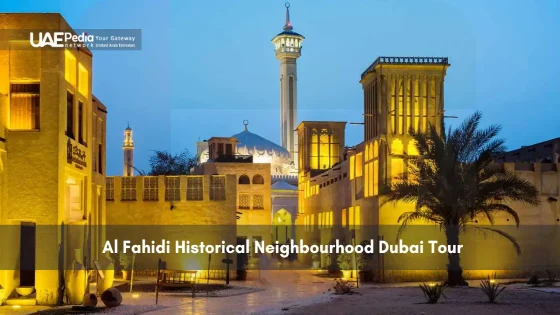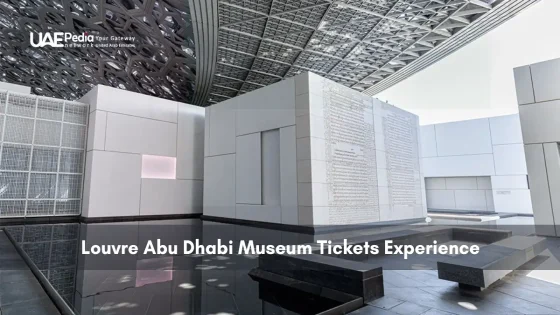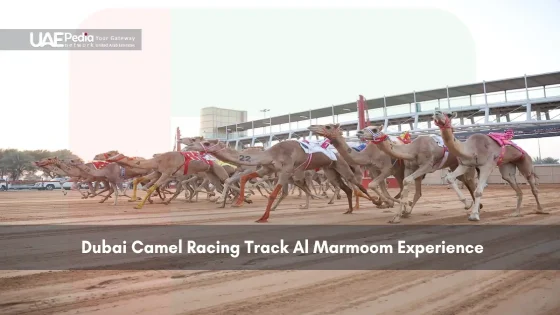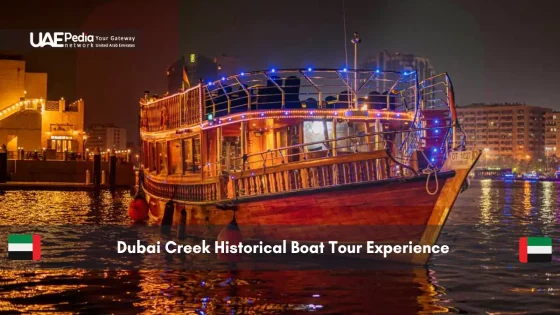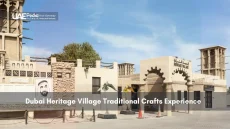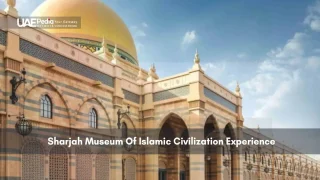Dubai’s skyline may stretch toward the future, but did you know its oldest surviving district dates back to the 1890s? Tucked between glass towers, this heritage site whispers stories of pearl divers, merchants, and wind towers that predate air conditioning. We’re stepping into a labyrinth where every sand-colored alley holds secrets older than the UAE itself.
Walk here, and you’ll trade smartphone maps for shaded pathways lined with coral-block buildings. Traditional barjeel wind towers—the region’s original climate control—still funnel cool breezes past wooden lattices. The scent of cardamom-spiced Arabic coffee drifts from courtyard cafes, while art galleries nestle in restored merchant houses.
At its heart lies the 1787 Al Fahidi Fort, home to the city’s first museum. Its exhibits reveal how Bedouin life evolved alongside bustling trade routes. Yet this area isn’t just about relics. Modern art installations blend with heritage architecture, proving history here breathes alongside innovation.
- Timeless contrast: Experience pre-oil era culture minutes from Dubai’s futuristic core
- Cultural layers: Museums, art hubs, and hidden eateries in one walkable maze
- Local rhythm: Sip karak chai where traders once haggled over spices
A Journey Through the Rich Heritage of Al Fahidi
Step off the metro into a labyrinth where spices once traded hands and wind towers cooled generations. This quarter doesn’t just preserve relics—it pulses with living traditions. We’re talking about the kind of time travel where you’ll find henna artists sketching patterns older than skyscrapers.
Understanding Its Historical Significance
In 1971, the same year the UAE formed, the Dubai Museum opened inside Al Fahidi Fort—a 1787 structure built from coral and gypsum. Its exhibits? Think pearl-diving dhows and desert star maps. But the real magic lies in walking through this heritage maze, where every restored merchant house hides stories of survival.
Cultural Evolution Through the Ages
Watch how Bedouin tents morph into courtyard galleries displaying cutting-edge Arab art. At the Sheikh Mohammed Centre, you’ll learn why dates symbolize hospitality or how falconry shaped trade routes. “We restored these walls using palm fronds and fish oil glue,” a conservator once told me—proof that tradition still guides preservation.
Today, this area draws global travelers seeking roots beneath the glitter. Yet between art cafes and souvenir stalls, you’ll catch elders playing mancala on shaded benches. That’s the heartbeat here: history isn’t behind glass—it’s sipping karak tea beside you.
Explore al fahidi historical neighbourhood dubai: What to See and Do
Imagine trading skyscrapers for spice-scented lanes where every corner whispers tales of pearl divers and ancient traders. This heritage maze rewards slow exploration—you’ll want to touch the sun-warmed coral walls and peer into hidden courtyards.
Museum Highlights and Iconic Landmarks
Start at the Dubai Museum in Al Fahidi Fort. Its underground galleries feel like stepping into a time capsule: pearl-diving weights, Bedouin jewelry, and a life-sized souq diorama. One visitor recently marveled, “You don’t just see history here—you hear the creak of wooden dhows.”
Three blocks east, the Coffee Museum serves cups of liquid culture. Roast dates over a 15th-century Ethiopian jebena pot or trace Arabia’s role in global trade routes. Pro tip: Their cardamom-infused gahwa pairs perfectly with sesame biscuits.
Architectural Marvels and Traditional Wind Towers
Look up—those geometric shapes crowning rooftops aren’t decorations. These wind towers funneled breezes into homes long before AC existed. Wander narrow alleys to spot:
- Carved teak doors with mashrabiya screens filtering sunlight
- Courtyard houses using shaded cross-ventilation
- Restored merchant homes doubling as art spaces
Compact layout means you can cover key spots in 90 minutes—but linger. Sit where traders once bargained, and you’ll feel centuries collapse like folded origami.
Navigating the Historic District: Transportation and Access
Exploring this heritage gem feels like time travel—but getting here blends old-world charm with modern convenience. Let’s map your route through centuries.
Public Transit and Metro Options
Hop on Dubai Metro’s Green Line to Sharaf DG Station—it’s a 7-minute walk to the quarter’s entrance. Prefer buses? Routes C5 and 33 stop near Ali Bin Abi Taleb Street. Pro tip: Download the RTA Dubai app for real-time updates. Early birds (before 10 AM) beat both crowds and heat.
| Mode | Route | Travel Time | Tip |
|---|---|---|---|
| Metro | Green Line to Sharaf DG | 12 mins from BurJuman | Buy a Nol Card |
| Bus | C5 from Gold Souq | 18 mins | Window seats for views |
| Abra | Deira Old Souq Station | 5 mins | Pay with coins |
| Taxi | Anywhere to Bastakiya | Varies | Use Careem app |
Taxis, Abras, and Car Hire Tips
For a fun contrast, pair a taxi ride with an abra boat trip from Deira’s docks. Ride-hailing apps work best during rush hours (7-9 AM, 5-7 PM). Driving? Book through Discover Cars—their full-coverage plans ease parking stress. Limited spots? Try Al Fahidi Parking Lot off 314th Road.
First-time visitors love guided walking tours. Grab free maps at metro stations—they highlight shaded pathways perfect for midday strolls. Wheelchair-friendly routes begin at the main fort entrance.
Sunset hours (4-6 PM) offer golden light for photos and cooler temps. Weekend mornings buzz with local families—come weekdays for quieter lanes. However you arrive, let the journey become part of the story.
Cultural Experiences: Museums, Tea Houses, and Art Galleries
Think museums are just glass cases and dusty artifacts? Not here. This quarter turns cultural discovery into a full-sensory adventure—where you’ll grind coffee beans from ancient recipes and handle coins that crossed deserts centuries ago.
Diving into Dubai Museum and Coin Museum Exhibits
The Dubai Museum’s underground galleries feel like stepping into a time machine. Touch replicas of pearl divers’ tools, then follow the story of how this fort became the city’s first cultural guardian. Nearby, the Coin Museum sparkles with silver dirhams minted when camels were the original delivery trucks. “Holding a 1791 coin gave me chills,” a recent visitor shared. “You realize trade never really changed—just the payment methods.”
Authentic Encounters at the Coffee Museum and Sheikh Mohammed Center
At the Coffee Museum, your nose leads the way. Roast beans using a 19th-century Turkish cezve, then sip Yemeni-style brew poured from a brass dallah. For deeper connections, book a lunch at the Sheikh Mohammed Centre. Over shared plates of machboos, locals explain why dates symbolize generosity or how Bedouin poetry shaped trade routes.
| Venue | Experience | Pro Tip |
|---|---|---|
| Dubai Museum | Fort-to-museum evolution | Arrive early to avoid school groups |
| Coffee Museum | Hands-on brewing sessions | Try the Omani kahwa with dried limes |
| Sheikh Mohammed Centre | Cultural Q&A over meals | Book 3 days ahead for dinner slots |
Art lovers, save time for the hidden galleries tucked behind teak doors. Many double as tea houses serving saffron-infused karak chai. By sunset, you’ll realize these stops aren’t just educational—they’re living chapters of a story still being written.
Hidden Gems: Traditional Architecture and Unique Exhibits
While Dubai races toward tomorrow, these narrow lanes preserve the genius of yesterday’s builders. Beyond the main thoroughfares, you’ll find engineering marvels that turned harsh climates into livable spaces—no electricity required.
Discovering Wind Towers and Courtyard Designs
Those geometric rooftop towers? Ancient air conditioners. Built from coral blocks and gypsum mortar, they captured breezes 30 feet above ground, funneling cool air through homes. Courtyards acted as natural chill zones—shaded retreats where families gathered beneath date palms.
| Traditional Feature | Modern Equivalent | Innovation |
|---|---|---|
| Wind towers | AC vents | Passive cooling via airflow |
| Mashrabiya screens | Window blinds | Sunlight filtration + privacy |
| Coral walls | Concrete | Natural insulation |
“You realize these builders were climate scientists,” remarked a recent visitor tracing her fingers along a 19th-century wall. The materials tell stories: crushed seashells in plaster, palm wood reinforcements, and mud bricks mixed with goat hair.
Local Art Installations and Heritage Walkways
Today’s artists reinterpret tradition along shaded paths. Look for:
- Metal sculptures mimicking wind tower silhouettes
- Mosaic pathways using pottery shards
- Projected light shows on weathered walls
One courtyard hides a calligraphy installation where Arabic script dances across water features. These creative touches transform the quarter into a living gallery—no admission ticket needed.
Wander slowly. Notice how sun angles reveal hidden patterns in latticework, or how evening shadows turn alleys into abstract art. Here, every cracked doorframe whispers, “Look closer.”
Local Flavors and Hospitality: Dining and Accommodations
Let your nose lead the way—cinnamon, saffron, and freshly baked khameer bread swirl through shaded courtyards. This quarter proves Emirati cuisine isn’t just food—it’s edible storytelling.
Savoring Emirati Cuisine at Traditional Cafes
At the Arabian Tea House, breakfast begins with golden pancakes drizzled with date syrup. Locals swear by their balaleet—sweet vermicelli topped with fluffy eggs. “First sip of cardamom coffee here ruined Starbucks for me,” laughed a recent visitor from Texas.
For lunch, follow the scent of slow-cooked lamb to Al Fanar Restaurant. Their machboos (spiced rice with meat) arrives in copper pots, just like Bedouin families shared for generations. Save room for luqaimat—crispy dough balls dipped in silky date molasses.
Evening tea? Hidden gems like Local House serve mint-infused karak chai in clay cups. Ask for the “secret” sesame cookies—they’re not on the menu but always available.
| Spot | Must-Try | Pro Tip |
|---|---|---|
| Arabian Tea House | Camel burger + saffron cake | Arrive before 9 AM for courtyard seats |
| XVA Art Hotel Café | Rosewater lemonade | Pair with their date-sweetened cheesecake |
| Al Khayma Heritage | Emirati breakfast platter | Book the rooftop for sunset views |
When night falls, retreat to boutique stays like XVA Art Hotel—a 19th-century merchant’s home turned gallery-residence. Rooms blend carved wooden screens with rain showers, proving heritage and comfort aren’t opposites. “Falling asleep under wind towers feels like time travel,” shared a guest from Seattle.
Morning joggers find fresh regag bread at hole-in-wall bakeries. Night owls swap stories over oud-scented shisha in lantern-lit courtyards. Whether you stay an hour or a week, every meal here whispers: “Welcome home.”
Final Reflections on Your Al Fahidi Historical Neighbourhood Journey
Time folds here like desert sand meeting concrete—one moment you’re tracing wind towers older than skyscrapers, the next sipping cardamom coffee beside digital nomads. This corner of the city isn’t just about preserving relics. It’s where merchants’ whispers blend with gallery chatter, proving heritage thrives when shared.
Whether you lingered at the museum’s pearl-diving exhibits or debated art in a restored courtyard, these lanes leave imprints. Visitors often say the magic lies in details: sunlight filtering through wooden lattices, the clink of clay cups at hidden tea stalls, the way modern murals frame ancient walls.
Come early to catch golden-hour photos at quiet alleys. Book a guided walk to decode hidden symbols in architecture. Most importantly—return. Every visit unveils new layers, like peeling an onion that somehow grows fuller with each layer removed.
Share your stories. Tag that wind tower selfie, post about the mint-infused karak chai that ruined your usual latte. Because this neighbourhood isn’t frozen in history—it’s a conversation between then and now, waiting for your voice to join.
This district preserves 19th-century Emirati life with coral-stone buildings, wind towers, and labyrinthine lanes. It’s where museums like Dubai Museum and the Coffee Museum anchor stories of trade, pearl diving, and Bedouin traditions—a living bridge between past and present.
Hop off at Al Fahidi Metro Station (Green Line)—it’s a 10-minute walk. Water taxis (abras) from Bur Dubai Abra Station also drop you near the creek-side entrance, blending practicality with old-world charm.
Yes! Free walking tours by the Sheikh Mohammed Centre for Cultural Understanding dive into Emirati architecture, local customs, and even include qahwa (Arabic coffee) tastings. Private guides can tailor routes to hidden art galleries or heritage houses.
Arabian Tea House Café serves saffron-infused karak chai and camel burgers in a flower-filled courtyard. For a deeper immersion, book a cultural meal at the Sheikh Mohammed Centre, where you’ll share stories over machboos (spiced rice) with locals.
Some restored homes, like Bait Al Waheeloo, allow you to step inside and see how these “early AC systems” funneled breezes to cool interiors. Look for houses with square towers and open rooftops—they’re functional art!
Narrow alleys and uneven pathways can be challenging, but main thoroughfares like the Heritage Village and major museums like the Coin Museum have ramps. Morning visits are quieter, making navigation easier.
